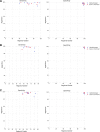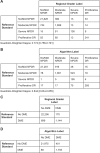Deep learning versus human graders for classifying diabetic retinopathy severity in a nationwide screening program
- PMID: 31304372
- PMCID: PMC6550283
- DOI: 10.1038/s41746-019-0099-8
Deep learning versus human graders for classifying diabetic retinopathy severity in a nationwide screening program
Erratum in
-
Erratum: Author Correction: Deep learning versus human graders for classifying diabetic retinopathy severity in a nationwide screening program.NPJ Digit Med. 2019 Jul 23;2:68. doi: 10.1038/s41746-019-0146-5. eCollection 2019. NPJ Digit Med. 2019. PMID: 31341955 Free PMC article.
Abstract
Deep learning algorithms have been used to detect diabetic retinopathy (DR) with specialist-level accuracy. This study aims to validate one such algorithm on a large-scale clinical population, and compare the algorithm performance with that of human graders. A total of 25,326 gradable retinal images of patients with diabetes from the community-based, nationwide screening program of DR in Thailand were analyzed for DR severity and referable diabetic macular edema (DME). Grades adjudicated by a panel of international retinal specialists served as the reference standard. Relative to human graders, for detecting referable DR (moderate NPDR or worse), the deep learning algorithm had significantly higher sensitivity (0.97 vs. 0.74, p < 0.001), and a slightly lower specificity (0.96 vs. 0.98, p < 0.001). Higher sensitivity of the algorithm was also observed for each of the categories of severe or worse NPDR, PDR, and DME (p < 0.001 for all comparisons). The quadratic-weighted kappa for determination of DR severity levels by the algorithm and human graders was 0.85 and 0.78 respectively (p < 0.001 for the difference). Across different severity levels of DR for determining referable disease, deep learning significantly reduced the false negative rate (by 23%) at the cost of slightly higher false positive rates (2%). Deep learning algorithms may serve as a valuable tool for DR screening.
Keywords: Developing world; Diabetes complications.
Conflict of interest statement
Competing interestsJ.K., R.S., K.W., B.J.L.C., G.S.C., L.P., S.P. and D.R.W. are Google employees and receive salary and stock as a part of the standard compensation package. O.K., J.J. and J.T. are consultants for Google.
Figures



References
-
- Jenchitr W, et al. The national survey of blindness low vision and visual impairment in thailand 2006–2007. Thai. J. Pub. Hlth. Ophthalmol. 2007;21:10.
LinkOut - more resources
Full Text Sources

